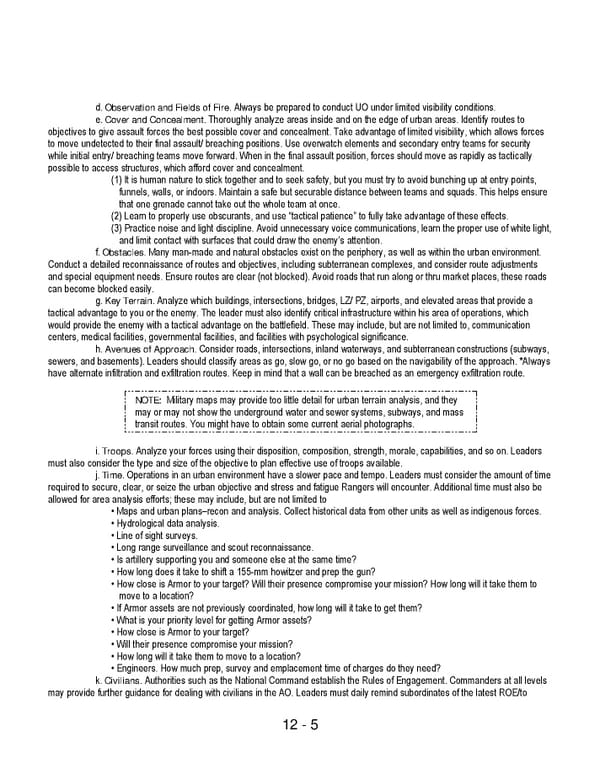12 - 5 d. Observation and Fields of Fire. Always be prepared to conduct UO under limited visibility conditions. e. Cover and Concealment. Thoroughly analyze areas inside and on the edge of urban areas. Identify routes to objectives to give assault forces the best possible cover and concealment. Take advantage of limited visibility, which allows forces to move undetected to their final assault/ breaching positions. Use overwatch elements and secondary entry teams for security while initial entry/ breaching teams move forward. When in the final assault position, forces should move as rapidly as tactically possible to access structures, which afford cover and concealment. (1) It is human nature to stick together and to seek safety, but you must try to avoid bunching up at entry points, funnels, walls, or indoors. Maintain a safe but securable distance between teams and squads. This helps ensure that one grenade cannot take out the whole team at once. (2) Learn to properly use obscurants, and use “tactical patience” to fully take advantage of these effects. (3) Practice noise and light discipline. Avoid unnecessary voice communications, learn the proper use of white light, and limit contact with surfaces that could draw the enemy’s attention. f. Obstacles. Many man-made and natural obstacles exist on the periphery, as well as within the urban environment. Conduct a detailed reconnaissance of routes and objectives, including subterranean complexes, and consider route adjustments and special equipment needs. Ensure routes are clear (not blocked). Avoid roads that run along or thru market places, these roads can become blocked easily. g. Key Terrain. Analyze which buildings, intersections, bridges, LZ/ PZ, airports, and elevated areas that provide a tactical advantage to you or the enemy. The leader must also identify critical infrastructure within his area of operations, which would provide the enemy with a tactical advantage on the battlefield. These may include, but are not limited to, communication centers, medical facilities, governmental facilities, and facilities with psychological significance. h. Avenues of Approach. Consider roads, intersections, inland waterways, and subterranean constructions (subways, sewers, and basements). Leaders should classify areas as go, slow go, or no go based on the navigability of the approach. *Always have alternate infiltration and exfiltration routes. Keep in mind that a wall can be breached as an emergency exfiltration route. NOTE: Military maps may provide too little detail for urban terrain analysis, and they may or may not show the underground water and sewer systems, subways, and mass transit routes. You might have to obtain some current aerial photographs. i. Troops. Analyze your forces using their disposition, composition, strength, morale, capabilities, and so on. Leaders must also consider the type and size of the objective to plan effective use of troops available. j. Time. Operations in an urban environment have a slower pace and tempo. Leaders must consider the amount of time required to secure, clear, or seize the urban objective and stress and fatigue Rangers will encounter. Additional time must also be allowed for area analysis efforts; these may include, but are not limited to • Maps and urban plans–recon and analysis. Collect historical data from other units as well as indigenous forces. • Hydrological data analysis. • Line of sight surveys. • Long range surveillance and scout reconnaissance. • Is artillery supporting you and someone else at the same time? • How long does it take to shift a 155-mm howitzer and prep the gun? • How close is Armor to your target? Will their presence compromise your mission? How long will it take them to move to a location? • If Armor assets are not previously coordinated, how long will it take to get them? • What is your priority level for getting Armor assets? • How close is Armor to your target? • Will their presence compromise your mission? • How long will it take them to move to a location? • Engineers. How much prep, survey and emplacement time of charges do they need? k. Civilians. Authorities such as the National Command establish the Rules of Engagement. Commanders at all levels may provide further guidance for dealing with civilians in the AO. Leaders must daily remind subordinates of the latest ROE/to
 Ranger Handbook Page 228 Page 230
Ranger Handbook Page 228 Page 230